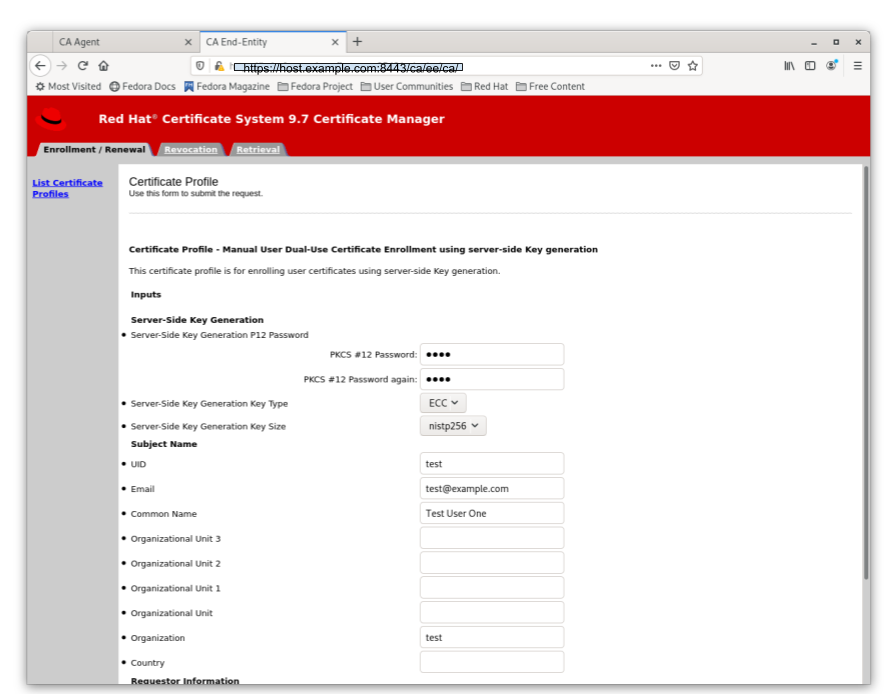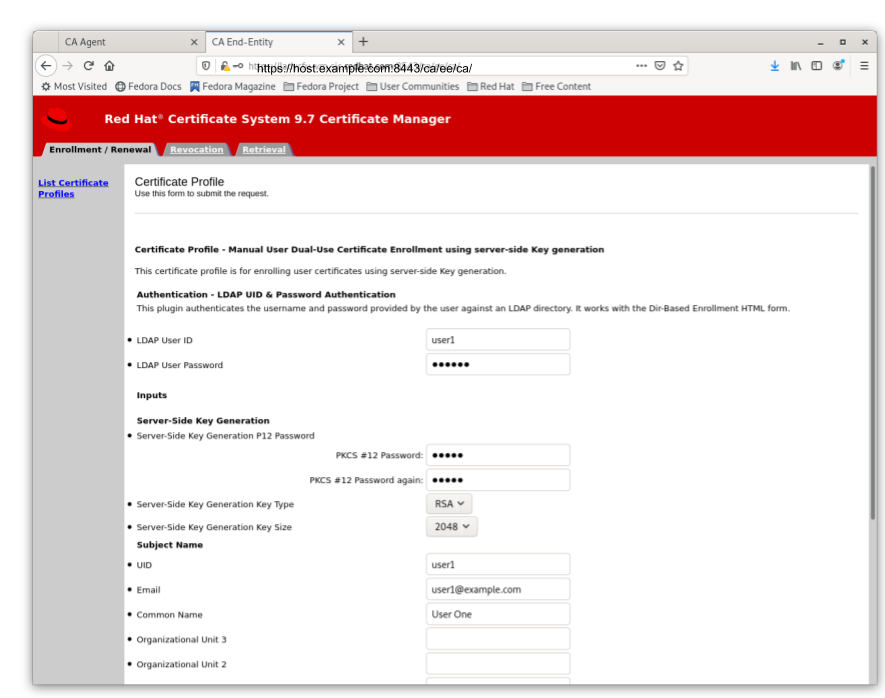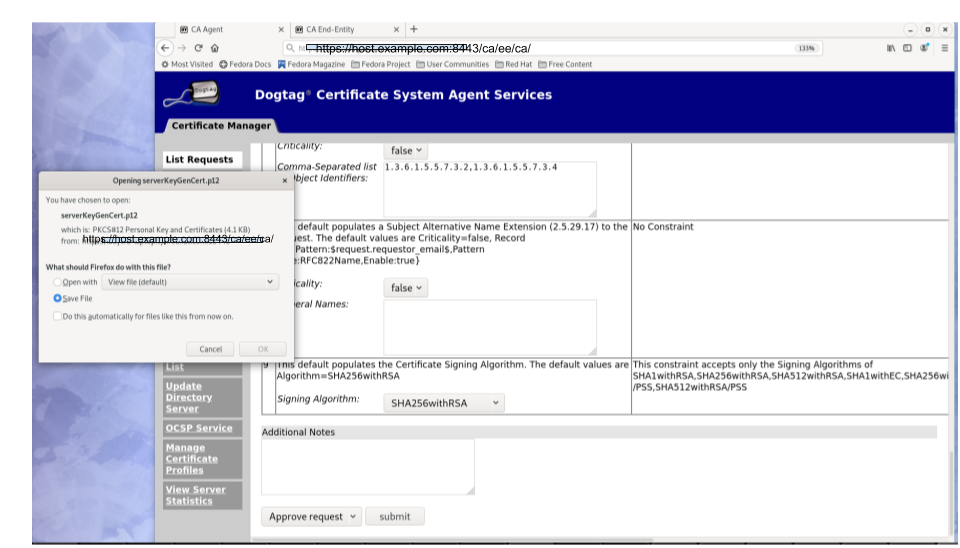Ce contenu n'est pas disponible dans la langue sélectionnée.
5.2. Creating Certificate Signing Requests
- Generating CSRs using command line utilities
- Generating CSRs inside a supporting browser
- Generating CSRs inside an application, such as the installer of a server
- Command-line utilities
- Server-Side Key Generation
5.2.1. Generating CSRs Using Command-Line Utilities
certutil: Supports creating PKCS #10 requests.PKCS10Client: Supports creating PKCS #10 requests.CRMFPopClient: Supports creating CRMF requests.pki client-cert-request: Supports both PKCS#10 and CRMF requests.
5.2.1.1. Creating a CSR Using certutil
certutil utility to create a CSR.
certutil, see:
- The certutil(1) man page
- The output of the
certutil --helpcommand
5.2.1.1.1. Using certutil to Create a CSR with EC Keys
certutil utility to create an Elliptic Curve (EC) key pair and CSR:
- Change to the certificate database directory of the user or entity for which the certificate is being requested, for example:
$ cd /user_or_entity_database_directory/
- Create the binary CSR and store it in the
/user_or_entity_database_directory/request.csrfile:$ certutil -d . -R -k ec -q nistp256 -s "CN=subject_name" -o /user_or_entity_database_directory/request-bin.csr
Enter the required NSS database password when prompted.For further details about the parameters, see the certutil(1) man page. - Convert the created binary format CSR to PEM format:
$ BtoA /user_or_entity_database_directory/request-bin.csr /user_or_entity_database_directory/request.csr
- Optionally, verify that the CSR file is correct:
$ cat /user_or_entity_database_directory/request.csr MIICbTCCAVUCAQAwKDEQMA4GA1UEChMHRXhhbXBsZTEUMBIGA1UEAxMLZXhhbXBs ...
This is a PKCS#10 PEM certificate request.
5.2.1.1.2. Using certutil to Create a CSR With User-defined Extensions
certutil utility.
- Change to the certificate database directory of the user or entity for which the certificate is being requested, for example:
$ cd /user_or_entity_database_directory/
- Create the CSR with user-defined Key Usage extension as well as user-defined Extended Key Usage extension and store it in the
/user_or_entity_database_directory/request.csrfile:$ certutil -d . -R -k rsa -g 1024 -s "CN=subject_name" --keyUsage keyEncipherment,dataEncipherment,critical --extKeyUsage timeStamp,msTrustListSign,critical -a -o /user_or_entity_database_directory/request.csr
Enter the required NSS database password when prompted.For further details about the parameters, see the certutil(1) man page. - Optionally, verify that the CSR file is correct:
$ cat /user_or_entity_database_directory/request.csr Certificate request generated by Netscape certutil Phone: (not specified) Common Name: user 4-2-1-2 Email: (not specified) Organization: (not specified) State: (not specified) Country: (not specified)
This is a PKCS#10 PEM certificate request.
5.2.1.2. Creating a CSR Using PKCS10Client
PKCS10Client utility to create a CSR.
PKCS10Client, see:
- The PKCS10Client(1) man page
- The output of the
PKCS10Client --helpcommand
5.2.1.2.1. Using PKCS10Client to Create a CSR
PKCS10Client utility to create an Elliptic Curve (EC) key pair and CSR:
- Change to the certificate database directory of the user or entity for which the certificate is being requested, for example:
$ cd /user_or_entity_database_directory/
- Create the CSR and store it in the
/user_or_entity_database_directory/example.csrfile:$ PKCS10Client -d . -p NSS_password -a ec -c nistp256 -o /user_or_entity_database_directory/example.csr -n "CN=subject_name"
For further details about the parameters, see the PKCS10Client(1) man page. - Optionally, verify that the CSR is correct:
$ cat /user_or_entity_database_directory/example.csr -----BEGIN CERTIFICATE REQUEST----- MIICzzCCAbcCAQAwgYkx ... -----END CERTIFICATE REQUEST-----
5.2.1.2.2. Using PKCS10Client to Create a CSR for SharedSecret-based CMC
PKCS10Client utility to create an RSA key pair and CSR for SharedSecret-based CMC. Use it only with the CMC Shared Secret authentication method which is, by default, handled by the caFullCMCSharedTokenCert and caECFullCMCSharedTokenCert profiles.
- Change to the certificate database directory of the user or entity for which the certificate is being requested, for example:
$ cd /user_or_entity_database_directory/
- Create the CSR and store it in the
/user_or_entity_database_directory/example.csrfile:$ PKCS10Client -d . -p NSS_password -o /user_or_entity_database_directory/example.csr -y true -n "CN=subject_name"
For further details about the parameters, see the PKCS10Client(1) man page. - Optionally, verify that the CSR is correct:
$ cat /user_or_entity_database_directory/example.csr -----BEGIN CERTIFICATE REQUEST----- MIICzzCCAbcCAQAwgYkx ... -----END CERTIFICATE REQUEST-----
5.2.1.3. Creating a CSR Using CRMFPopClient
CRMFPopClient utility to create a CSR.
CRMFPopClient, see the CRMFPopClient(1) man page.
5.2.1.3.1. Using CRMFPopClient to Create a CSR with Key Archival
CRMFPopClient utility to create an RSA key pair and a CSR with the key archival option:
- Change to the certificate database directory of the user or entity for which the certificate is being requested, for example:
$ cd /user_or_entity_database_directory/
- Retrieve the KRA transport certificate:
$ pki ca-cert-find --name "DRM Transport Certificate" --------------- 1 entries found --------------- Serial Number: 0x7 Subject DN: CN=DRM Transport Certificate,O=EXAMPLE Status: VALID Type: X.509 version 3 Key A lgorithm: PKCS #1 RSA with 2048-bit key Not Valid Before: Thu Oct 22 18:26:11 CEST 2015 Not Valid After: Wed Oct 11 18:26:11 CEST 2017 Issued On: Thu Oct 22 18:26:11 CEST 2015 Issued By: caadmin ---------------------------- Number of entries returned 1
- Export the KRA transport certificate:
$ pki ca-cert-show 0x7 --output kra.transport
- Create the CSR and store it in the
/user_or_entity_database_directory/example.csrfile:$ CRMFPopClient -d . -p password -n "cn=subject_name" -q POP_SUCCESS -b kra.transport -w "AES/CBC/PKCS5Padding" -v -o /user_or_entity_database_directory/example.csr
To create an Elliptic Curve (EC) key pair and CSR, pass the-a ec -t falseoptions to the command.For further details about the parameters, see the CRMFPopClient(1) man page. - Optionally, verify that the CSR is correct:
$ cat /user_or_entity_database_directory/example.csr -----BEGIN CERTIFICATE REQUEST----- MIICzzCCAbcCAQAwgYkx ... -----END CERTIFICATE REQUEST-----
5.2.1.3.2. Using CRMFPopClient to Create a CSR for SharedSecret-based CMC
CRMFPopClient utility to create an RSA key pair and CSR for SharedSecret-based CMC. Use it only with the CMC Shared Secret authentication method which is, by default, handled by the caFullCMCSharedTokenCert and caECFullCMCSharedTokenCert profiles.
- Change to the certificate database directory of the user or entity for which the certificate is being requested, for example:
$ cd /user_or_entity_database_directory/
- Retrieve the KRA transport certificate:
$ pki ca-cert-find --name "DRM Transport Certificate" --------------- 1 entries found --------------- Serial Number: 0x7 Subject DN: CN=DRM Transport Certificate,O=EXAMPLE Status: VALID Type: X.509 version 3 Key A lgorithm: PKCS #1 RSA with 2048-bit key Not Valid Before: Thu Oct 22 18:26:11 CEST 2015 Not Valid After: Wed Oct 11 18:26:11 CEST 2017 Issued On: Thu Oct 22 18:26:11 CEST 2015 Issued By: caadmin ---------------------------- Number of entries returned 1
- Export the KRA transport certificate:
$ pki ca-cert-show 0x7 --output kra.transport
- Create the CSR and store it in the
/user_or_entity_database_directory/example.csrfile:$ CRMFPopClient -d . -p password -n "cn=subject_name" -q POP_SUCCESS -b kra.transport -w "AES/CBC/PKCS5Padding" -y -v -o /user_or_entity_database_directory/example.csr
To create an EC key pair and CSR, pass the-a ec -t falseoptions to the command.For further details about the parameters, see the output of theCRMFPopClient --helpcommand. - Optionally, verify that the CSR is correct:
$ cat /user_or_entity_database_directory/example.csr -----BEGIN CERTIFICATE REQUEST----- MIICzzCCAbcCAQAwgYkx ... -----END CERTIFICATE REQUEST-----
5.2.1.4. Creating a CSR using client-cert-request in the PKI CLI
pkicommand-line tool can also be used with the client-cert-request command to generate a CSR. However, unlike the previously discussed tools, CSR generated with pki are submitted directly to the CA. Both PKCS#10 or CRMF requests can be generated.
pki -d user token db directory -P https -p 8443 -h host.test.com -c user token db passwd client-cert-request "uid=test2" --length 4096 --type pkcs10
pki -d user token db directory -P https -p 8443 -h host.test.com -c user token db passwd client-cert-request "uid=test2" --length 4096 --type crmf
ca-cert-request-approve command.
pki -d agent token db directory -P https -p 8443 -h host.test.com -c agent token db passwd -n <CA agent cert nickname> ca-cert-request-approve request id
pki client-cert-request --help command.
5.2.2. Generating CSRs Using Server-Side Key Generation
CRMFPopClient (see CRMFPopClient --help) or pki (see pki client-cert-request --help) could be used as a workaround.
Note
5.2.2.1. Functionality Highlights
- Certificate request keys are generated on the KRA (Note: a KRA must be installed to work with the CA)
- The profile default plugin,
serverKeygenUserKeyDefaultImpl, provides selection to enable or disable key archival (i.e. the enableArchival parameter) - Support for both RSA and EC keys
- Support for both manual (agent) approval and automatic approval (e.g. directory password-based)
5.2.2.2. Enrolling a Certificate Using Server-Side Keygen
Manual User Dual-Use Certificate Enrollment Using server-side Key generation

Figure 5.1. Server-Side Keygen Enrollment that requires agent manual approval
Directory-authenticated User Dual-Use Certificate Enrollment Using server-side Key generation

Figure 5.2. Server-Side Keygen Enrollment that will be automatically approved upon successful LDAP uid/pwd authentication
Important
- In case of manual approval, the PKCS#12 file will be returned to the CA agent that approves the request; the agent is then expected to forward the PKCS#12 file to the user.
- In case of automatic approval, the PKCS#12 file will be returned to the user who submitted the request

Figure 5.3. Enrollment manually approved by an agent
pkcs12util to import this file into their own user internal cert/key database for each application. E.g. the Firefox nss database of the user.
5.2.2.3. Key Recovery
5.2.2.4. Additional Information
5.2.2.4.1. KRA Request Records
Note
- One for the request type asymkeyGenRequestThis request type cannot be filtered using List Requests on the KRA agent page; you can select Show All Requests to see them listed.
- One for the request type recovery
5.2.2.4.2. Audit Records
- SERVER_SIDE_KEYGEN_ENROLL_KEYGEN_REQUEST
- SERVER_SIDE_KEYGEN_ENROLL_KEY_RETRIEVAL_REQUEST
- SERVER_SIDE_KEYGEN_ENROLL_KEYGEN_REQUEST_PROCESSED
- SERVER_SIDE_KEYGEN_ENROLL_KEY_RETRIEVAL_REQUEST_PROCESSED (not yet implemented)